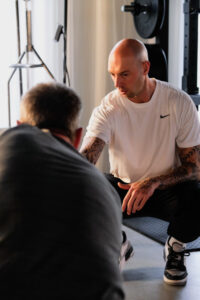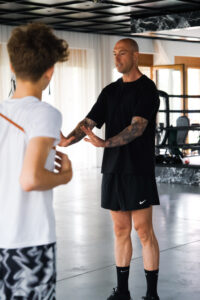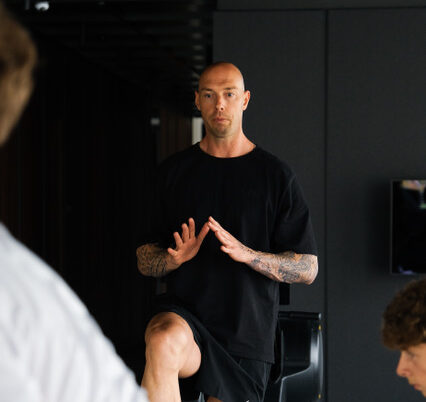Below, BSc in Strength & Conditioning student Michael Krikemans discusses his journey into S&C, how he approaches working with athletes vs the general population and his experience as a student of Setanta.
From Professional Basketball to S&C
Michael’s journey into strength and conditioning began in the world of professional basketball, where he competed at national and international levels across Europe. An unexpected injury changed his path and opened up new opportunities. “After building my career through Europe as a professional basketball player, I suffered an injury that forced me to take a new direction. I had to step away from competing at the international and national levels, but that moment pushed me to start a new personal journey,” he shared.
“I began focusing on different aspects of training, nutrition, and lifestyle. Friends, family and sport-minded people started asking questions and advice to help them out with strength training, programming, and nutrition. Now, as a personal trainer and coach, I use my own experiences and build up knowledge to help others achieve their personal needs and guide them to an overall healthier lifestyle.” 
Working in Basketball
Michael discussed his current role with BBC Kontich Wolves.
“In my current role as the strength coach, I am responsible for both the men’s basketball team and youth development of the U16 team. This includes managing off-season, pre-season, and in-season sessions, game preparation, and warm-ups, as well as overseeing their nutrition and recovery supplementation both during and after games.
In an amateur setting like ours, it’s not just about managing the number of games or training sessions but balancing the demands of work, study, family, and training,” he explained.
“When working with basketball players and preparing them for a season, my main priorities are ensuring they remain healthy and resilient throughout the year. First and foremost, I focus on building a strong athletic foundation “building the engine” by developing the main physical qualities like strength, power, endurance, speed, agility and COD.
Another critical area is injury prevention or what I like to call “injury mitigation”. Preventing injuries is a term which I don’t like to use too much due the fact that we, as coaches can only prepare our players as best as possible towards the demands of the game. And the game of basketball is “chaos”! But I emphasize improving their mobility, stability and flexibility. Strengthening the stabilising muscles around the knees, hips and ankles is also essential for maintaining joint stability under the stress of jumping, landing, cutting, and other basketball movements. Furthermore, I ensure proper load management, gradually increasing training intensity to avoid overtraining and encourage proper recovery.
Finally, I emphasise recovery and nutrition. After training sessions and games, I educate players on the importance of proper recovery techniques—from sleep and hydration to more advanced modalities like foam rolling or ice baths. In terms of nutrition, I provide guidance on diet and supplementation, ensuring players are fueling their bodies correctly for both energy during games and recovery afterward.”

Youth Development and Personal Training
Having worked with both experienced players and younger athletes Michael highlights the importance of tailoring your coaching approach to fit each group, recognising the unique challenges young athletes face. “A crucial aspect of coaching youth athletes is recognizing that we cannot train young, developing players the same way we train adults. During their development, many young athletes experience growth spurts, which often come with challenges like growth plate injuries, Osgood-Schlatter disease, and patellar tendinitis. These conditions require us to pay extra attention to load monitoring and proper training education,” he explained.
For Michael, youth development is about long-term progress, ensuring a safe environment that supports healthy growth. “ during these phases of rapid growth. Ensuring a safe, structured environment that supports healthy development is key to keeping them progressing while minimizing the risk of injury. Youth development = LONG TERM!”
In addition to his work with basketball teams, Michael is also a dedicated personal trainer. He tailors training sessions and programs to meet the unique needs of each client, focusing on strength training, cardiovascular conditioning, flexibility, and mobility.
“I begin by assessing each client’s current fitness level, goals, and any limitations or injuries they may have or had in the past. Based on that, I create a plan that balances strength training, cardiovascular conditioning, flexibility, and mobility work to optimize their overall fitness.” Michael emphasises “the importance of proper technique to minimize injury and maximize the effectiveness of their workouts” to his clients and “emphasises the fundamentals of movement, ensuring that they perform exercises safely and efficiently.”
“The approach for athletes is highly specialised, performance-oriented, and intense, with a major focus on balancing training, recovery, and injury mitigation,” he said. However “for the general population, the approach is more focused on overall health, fitness, and longevity, with an emphasis on making training accessible and sustainable. Understanding these differences allows me to better serve each individual or group and help them reach their specific goals.”
Valuable Lessons from Studying with Setanta
“The workshops were a valuable experience, with a good mix of practical and theoretical learning, plus the chance to connect with other students at Setanta College,” he shared.
“The various modules in the BSc in Strength and Conditioning provide a good structure that gives you as a coach sufficient time to combine the learning material with current practice.”
For aspiring S&C Coaches or Personal Trainers Michael offers some valuable advice: “Be passionate about what you do – build a solid knowledge foundation through education and credentials – gain as much practical experience as possible – don’t forget your soft skills – dare to make mistakes, adapt and grow – connect with peers, colleagues, organizations.”


Leave A Comment